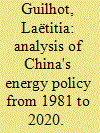| Srl | Item |
| 1 |
ID:
183587


|
|
|
|
|
| Summary/Abstract |
Looking back at four decades of China's energy policy (1981–2020), three momentous shifts can be said to have taken place. From the Sixth Five-Year Plan (1981) to the Ninth Five-Year Plan (2000), the focus was exclusively on improving energy efficiency. Subsequently, from the Tenth Five-Year Plan (2001) to the Eleventh Five-Year Plan (2010), energy security also became a major objective, as awareness of the gradual depletion of fossil fuels grew. From 2011 onwards (Twelfth and Thirteenth Five-Year Plans), China's energy policy has also aimed to ward off climate change. This policy evolution suggests that the Chinese economy has initiated a low-carbon energy transition since 2011. Nevertheless, this transition cannot be considered sustainable because the local government are reluctant to apply stringent institutional limitations to wealth-creating processes within their jurisdiction and because China's energy consumption is not decoupled from its economic growth and total environmental costs of renewable energy are not taken account. In seeking to usher in a sustainable energy system, the Chinese government needs to overcome three challenges: 1/an institutional challenge; 2/an economic challenge and 3/an environmental challenge.
|
|
|
|
|
|
|
|
|
|
|
|
|
|
|
|
| 2 |
ID:
096720


|
|
|
|
|
| Publication |
2010.
|
| Summary/Abstract |
China's growing demand for energy - and its dependence on coal - has seen its carbon emissions increase more than 50% since 2000. Within the debate about mitigating global climate change, there is mounting pressure for emerging economies like China to take more responsibility for reducing their carbon emissions within a post-2012 international climate change policy framework. For China, this leads to fundamental questions about how feasible it is for the country to shift away from its recent carbon intensive pattern of growth. This paper presents some general results of scenarios that have been developed to investigate how China might continue to develop within a cumulative carbon emissions budget. The results show how changes in the key sectors of the Chinese economy could enable China to follow four different low carbon development pathways, each of which complies with a cumulative emissions constraint. Each scenario reflects different priorities for governmental decision making, infrastructure investments and social preferences. Having compared the key features of each scenario, the paper concludes with some implications for Chinese government policy.
|
|
|
|
|
|
|
|
|
|
|
|
|
|
|
|
| 3 |
ID:
097513


|
|
|
|
|
| Publication |
2010.
|
| Summary/Abstract |
China's growing demand for energy - and its dependence on coal - has seen its carbon emissions increase more than 50% since 2000. Within the debate about mitigating global climate change, there is mounting pressure for emerging economies like China to take more responsibility for reducing their carbon emissions within a post-2012 international climate change policy framework. For China, this leads to fundamental questions about how feasible it is for the country to shift away from its recent carbon intensive pattern of growth. This paper presents some general results of scenarios that have been developed to investigate how China might continue to develop within a cumulative carbon emissions budget. The results show how changes in the key sectors of the Chinese economy could enable China to follow four different low carbon development pathways, each of which complies with a cumulative emissions constraint. Each scenario reflects different priorities for governmental decision making, infrastructure investments and social preferences. Having compared the key features of each scenario, the paper concludes with some implications for Chinese government policy.
|
|
|
|
|
|
|
|
|
|
|
|
|
|
|
|
| 4 |
ID:
161838


|
|
|
|
|
| Summary/Abstract |
An important environmental consequence of subsidies for fossil fuels is that it encourages the substitution from renewable energy, capital and labor to fossil fuels, and thus impedes the low carbon transition. To reduce energy consumption and energy-related greenhouse gas emissions, there is a renewed interest in phasing out fossil fuel subsidies. In policy debates, it is commonly believed that fossil fuel subsidies encourage wasteful energy consuming, and thus removing them would depress energy-related carbon dioxide (CO2) emissions. But whether it is the real case and the magnitude of mitigation by removing fossil fuel subsidies are still unanswered. Here we provide an opposite insight in this paper. We find that fossil fuel subsidies in China might have been removed in total in 2015, but further attention should be paid to whether the removal is caused by the market condition of low energy prices, or by the on-going market-oriented reforms. Furthermore, during the periods with positive subsidies, removing fossil fuel subsidies alone cannot achieve CO2 mitigation because it would lead to the substitution from low-emitted fuels to high-emitted coal and from capital and labor to energy. Our results demonstrate that additional policies and efforts will be required to fulfill the aspirations for low carbon economy. The findings in this paper may be extended to emerging and developing countries due to their similar conditions of fossil fuel subsidies.
|
|
|
|
|
|
|
|
|
|
|
|
|
|
|
|